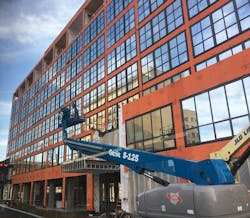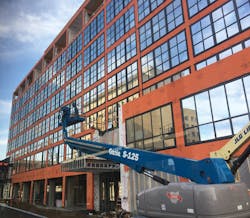Nail Pouch Half-full: Commercial Construction Contractors Remain Upbeat
Washington, D.C. — Contractors continue to face a shortage of building materials like lumber and steel, while cost fluctuations for the building products are having increasing impact on business, according to second quarter data from the U.S. Chamber of Commerce Commercial Construction (Index). This quarter, 84 percent of contractors are facing at least one material shortage. Almost half (46 percent) of contractors say reduced availability of building products has been a top concern lately, up from 33 percent who indicated this last quarter.
(But today, we read in the Wall Street Journal that lumber prices are tumbling after 100+ percent price hikes. So that's a positive. - ed.)
Despite the materials challenges, the overall Index score rose three points to 65 (its highest reading since a score of 74 in Q1 2020 ahead of the pandemic) and contractors are optimistic on outlook for revenue expectations, new business opportunities, hiring plans, and equipment spending.
'Contractors continue to face challenges navigating materials shortages and finding enough skilled workers to avoid having to turn down projects. That’s why the U.S. Chamber is calling on elected leaders at the federal and state level to take action to address the workforce crisis.' - Neil Bradley
- 89 percent of contractors report a moderate to high level of confidence in new business opportunities in the next 12 months, up from 86 percent in Q1. Those indicating a high level of confidence jumped 10 points to 34 percent from last quarter.
- Over half (52 percent) of contractors say they will hire more employees in the next six months, up from 46 percent in Q1.
- More contractors (39 percent) expect their revenue to increase in the next year, up from 36 percent saying the same in Q1.
- For the first time in a year, the percentage of contractors planning to spend more on tools and equipment in the next six months (44 percent) is higher than those who say they will not spend more (42 percent).
Materials Shortages Worsen
Most (84 percent) contractors say they face at least one material shortage, up from 71 percent in Q1. One in three (33 percent) are experiencing a shortage in wood/lumber, and 29 percent are seeing a shortage of steel. Of those contractors experiencing shortages, 46 percent say they are having a high impact on projects, up from 20 percent saying the same in Q1.
Additionally, 94 percent of contractors say cost fluctuations are having a moderate to high impact on their business, up 12 percentage points from Q1 and up 35 points year-over-year. Wood/lumber and steel are the products of highest concern.
Contractors Face Worker Shortage Crisis
In the midst of a deepening workforce crisis, finding skilled labor continues to be a challenge for contractors. This quarter, 88% report moderate to high levels of difficulty finding skilled workers, of which, nearly half (45 percent) report a high level of difficulty. Of those who reported difficulty finding skilled labor, over a third (35 percent) have turned down work because of skilled labor shortages.
Most (87 percent) contractors also report a moderate to high level of concern about the cost of skilled labor. Of those who expressed concern, 64 percent say the cost has increased over the past six months, and more than three-quarters (77 percent) expect it to continue to increase over the next year.
Trade and Tariff Concerns are Up
This quarter, contractors expressed increasing concern about the potential effect of tariffs and trade wars on access to materials over the next three years.
More (45 percent) say steel and aluminum tariffs will have a high to very-high degree of impact, up from 35 percent in Q1. Forty percent now say new construction material and equipment tariffs will have a high to very-high degree of impact, up from 29 percent in Q1. And 30 percent expect high impacts from trade conflicts with other countries, up from 19 percent in Q1.
About the Index
The U.S. Chamber of Commerce Commercial Construction Index is a quarterly economic index designed to gauge the outlook for, and resulting confidence in, the commercial construction industry. The Index comprises three leading indicators to gauge confidence in the commercial construction industry, generating a composite Index on the scale of 0 to 100 that serves as an indicator of health of the contractor segment on a quarterly basis.
The Q2 2021 results from the three key drivers are:
- Revenue: Contractors’ revenue expectations over the next 12 months increased to 61 (up four points from Q1).
- New Business Confidence: The overall level of contractor confidence increased to 62 (up three points from Q1).
- Backlog: The ratio of average current to ideal backlog rose three points to 72 (up three points from Q1).
The research was developed with Dodge Data & Analytics (DD&A), the leading provider of insights and data for the construction industry, by surveying commercial and institutional contractors.
Visit www.CommercialConstructionIndex.com to access the full report, methodology, and shareable graphics.

